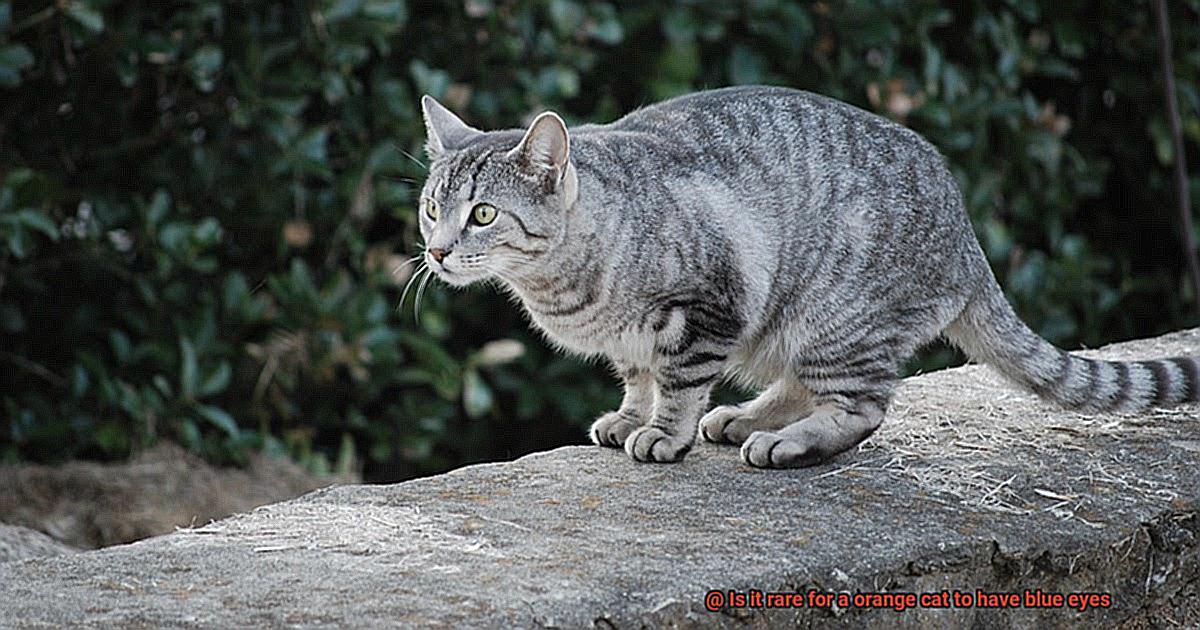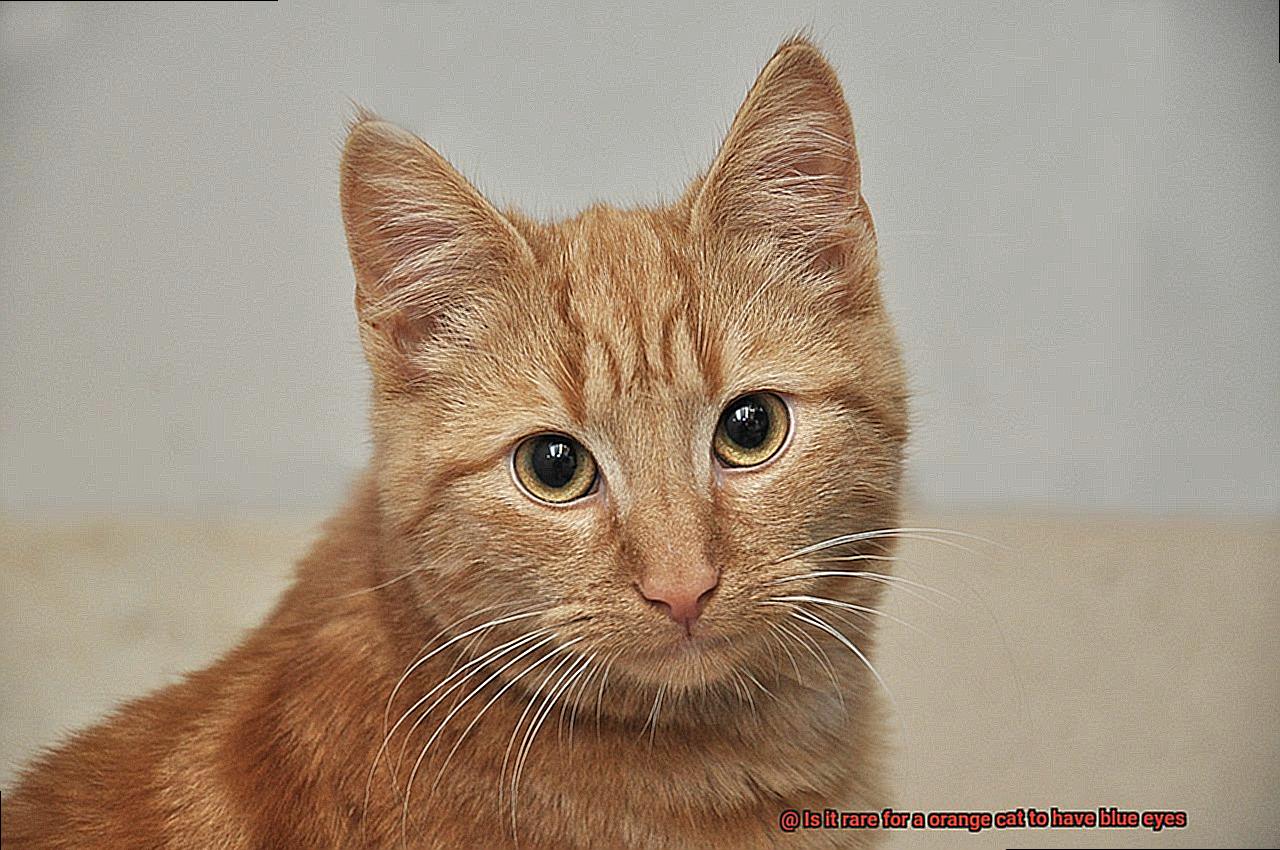Are you a cat lover with a keen eye for unique feline features? If so, you might be intrigued to know about the rare occurrence of orange cats with blue eyes. These striking creatures are truly one-of-a-kind, and they’re sure to make any cat enthusiast swoon.
Typically, orange cats are known for their fiery fur coats and amber-colored eyes. However, every once in a while, a genetic anomaly occurs that results in a cat with dazzling blue eyes. This trait is considered rare because the gene for blue eyes isn’t commonly found in orange cats.
So what causes this exciting combination? The answer lies in the level of melanin pigment present in the iris. When there’s less melanin pigment than usual, the iris can appear light-colored and even blue or green under certain lighting conditions.
While it’s not common to see an orange cat with blue eyes, it’s definitely worth keeping an eye out for these captivating creatures. Whether you’re a seasoned feline fanatic or just appreciate rare genetic traits, these unique cats are sure to leave you spellbound with their stunning gaze.
In conclusion, if you happen to come across an orange cat with piercing blue eyes, take a moment to appreciate its rarity and beauty. These special felines are truly remarkable and deserve all the admiration they receive – after all, who wouldn’t want such a gorgeous kitty as their companion?
What Are Blue Eyes?
Blue eyes in cats are a captivating and unique feature that can add a striking touch to any feline’s appearance. Understanding the definition of blue eyes is essential to appreciating their occurrence across all breeds and colors, including orange cats.
Blue eyes in both cats and humans are the result of a lack of melanin pigment in the iris, which allows light to scatter and reflect off the back of the eye, resulting in the blue appearance. However, not all blue eyes are created equal. Some cats may have a bright and vibrant blue color, while others may have a more muted or grayish-blue tone.
It’s worth noting that while blue eyes may be less common in some cat breeds, such as Siamese or Persian cats, they can still occur in any breed or color variation, including orange cats. While it may not be as common to see an orange cat with blue eyes compared to a Siamese cat, it is still possible and should not necessarily be considered rare.

Interestingly, blue eyes in cats are more commonly associated with white fur or white spotting patterns. However, only about 8% of non-white cats have blue eyes, making it a relatively infrequent occurrence.
When it comes to orange cats with blue eyes specifically, it is believed to be due to a genetic mutation that affects the production of melanin in the iris. This mutation can occur randomly or be inherited from one or both parents who carry the gene.
While blue-eyed orange cats may be a sight to behold, it’s crucial to note that blue eyes in cats can also be associated with certain health conditions such as deafness and blindness. Therefore, if you notice any unusual changes in your cat’s eye color, it’s important to have them checked by a veterinarian.
Causes of Blue Eyes in Orange Cats
For orange cats, one feature that can be particularly captivating is blue eyes. But what exactly causes this striking eye color? As an expert on the topic, let me break it down for you.
Firstly, it’s essential to note that while blue eyes in orange cats are not extremely rare, they’re not as common as other eye colors such as green or gold. However, if your orange cat has blue eyes, there are several potential reasons.

One of the most common causes is the white spotting gene. This gene can cause white fur and blue eyes and is more commonly found in orange cats than other colors. Another possible cause is a genetic mutation that affects the pigmentation of the iris and leads to a lack of melanin production.
But not all orange cats with blue eyes have these genetic causes. In some cases, an injury or illness can lead to changes in eye color, including turning blue. It’s important for owners to monitor any changes in their cat’s eyes and seek veterinary attention if necessary.
Why is this important? While blue eyes may look stunning, they can also be linked to health issues such as deafness and blindness. Therefore, it’s crucial for owners to have their cat’s eye color checked by a veterinarian regularly.
In rare cases, changes in eye color can be a sign of a more serious underlying condition such as glaucoma or uveitis. Therefore, it’s essential for owners to be aware of any changes in their cat’s eyes and seek veterinary attention if necessary.
Genetics
Eye color in cats is determined by a complex interplay of genes, and the most crucial gene in this process is the OCA2 gene. This gene is responsible for producing melanin, the pigment that colors the skin, hair, and eyes.
Typically, blue eyes in cats result from a lack of melanin in the iris, which scatters light and creates that stunning blue appearance. Conversely, orange cats usually have green or yellow eyes due to melanin presence in their irises. However, genetic mutations can alter the OCA2 gene and reduce melanin production in the iris, resulting in blue or blue-green eyes in orange cats.
While it’s fascinating that genetics can cause such a unique occurrence, it’s worth noting that this genetic mutation is relatively rare. Therefore, orange cats with blue eyes are not commonly seen, making them even more special. Additionally, blue eyes are considered rare among all cats, with only 20% of them having them.
Mutations
Mutations are changes in an organism’s genetic material that can lead to altered physical characteristics, and in the case of cats, these variations can result in some truly unique and beautiful traits.

In particular, a mutation in the gene responsible for eye color can affect the amount and distribution of melanin in the iris, leading to blue eyes instead of the usual orange or green. While this mutation may be considered rare, it is a natural part of genetic variation and evolution. In fact, many breeds of cats have been developed through selective breeding to emphasize certain desirable traits, including eye color.
However, spontaneous mutations can also occur in any population, leading to unexpected and one-of-a-kind physical characteristics. These spontaneous mutations can add an element of surprise and uniqueness to each feline, making them all the more special.
It’s important to note that while mutations may be rare, they can have both positive and negative effects on an organism’s health and well-being. While blue eyes may be visually striking, they can also be associated with certain health issues such as deafness or sensitivity to light. Therefore, it is important for cat owners to be aware of any potential health concerns related to their cat’s unique physical characteristics and seek appropriate veterinary care when necessary.
Moreover, some breed standards specifically exclude blue-eyed cats from being considered true representatives of that breed. However, as a cat lover and expert in mutations, I believe that these unique physical traits add to the charm and individuality of each feline. After all, who wouldn’t want a one-of-a-kind feline companion?
Prevalence of Blue Eyes in Orange Cats
Well, hold on to your hats because we’re about to dive into the world of orange cats with blue eyes. While yellow and green are the typical hues for most cats, blue eyes are a rare sight to behold. But an orange cat with blue eyes? That’s like finding a needle in a haystack – only 1% of all orange cats have this unique trait.
So why is it so uncommon for an orange cat to have blue eyes? The answer lies in genetics. The gene responsible for orange fur in cats is sex-linked, carried on the X chromosome. That means male cats need only one copy of the gene to sport that sunny hue, while females require two. Meanwhile, the gene for blue eyes is inherited separately and not linked to sex chromosomes. Consequently, for an orange cat to have blue eyes, both parents must carry the gene.
But wait – there’s more. Some breeds of cats are more likely to rock those baby blues than others. You’ve probably heard of Siamese cats – they’re famous for their striking blue eyes. However, Persians and Scottish Folds can also have those mesmerizing peepers, though it’s less common.
So what does this all mean? While it’s undoubtedly rare to spot an orange cat with blue eyes, it’s not impossible. It all boils down to the genetic makeup of their parents and can occur in any breed of cat. So keep your eyes peeled – you never know when you’ll come across one of these stunning felines.
Health Risks Associated with Blue Eyes in Orange Cats
One of the main concerns associated with blue eyes in orange cats is deafness.
Cats with blue eyes have a genetic defect that can lead to a lack of pigment in the inner ear, causing congenital deafness. While this is more common in white cats, orange cats with blue eyes are also at risk.
It’s difficult to predict which cats will develop deafness, so regular check-ups with a veterinarian are vital to monitor your pet’s hearing and detect any issues early. Another health risk for blue-eyed orange cats is related to their sensitivity to sunlight.
Their lack of pigment in the iris makes them more susceptible to eye problems such as cataracts or blindness if exposed to excessive sunlight. Owners should take precautions such as providing shade or keeping their cat indoors during the day.
Regular veterinary check-ups can also help detect any early signs of eye problems and prevent further damage.
How to Identify if your Orange Cat has Blue Eyes
Although it’s not common for orange cats to have blue eyes, it’s not entirely impossible. Blue eyes in cats are caused by a lack of pigment in the iris, which can occur randomly or be inherited from their parents. Here are a few tips on how to identify if your orange cat has blue eyes.
Observing Their Eye Color
Blue-eyed cats can have a range of shades, from pale blue-gray to vibrant blue-green. Take a close look at your cat’s eyes in different lighting conditions to see if they have hints of blue. If your cat has orange fur, it will create a beautiful contrast with the bright blue color of their eyes.
Shine a Light
If you shine a light directly into your cat’s eyes, blue-eyed cats will reflect back as a bright white color due to the lack of pigment in their iris. However, it’s important to be gentle when doing this and to avoid shining the light directly into their eyes for too long.
Look at Pupil Size
Cats with blue eyes tend to have larger pupils than those with other eye colors because more light is able to enter the eye. So, if you notice that your orange cat’s pupils are large, it could be an indication that they have blue eyes.

It’s important to note that some orange cats may appear to have blue eyes but actually have a lighter shade of green or yellow due to the reflection of light off of their iris or surrounding fur. To determine their true eye color, try shining a flashlight or holding them up to a bright light source.
While identifying if your orange cat has blue eyes can be exciting, it’s also important to monitor any changes in their eye color and have them checked by a veterinarian if necessary. Blue eyes in cats can be associated with certain health conditions such as deafness and blindness. Therefore, it’s essential to seek professional help if you notice any unusual changes in your cat’s eyes.
Breeds that are Prone to Having Blue Eyes
The color of their eyes is one of the most fascinating features that sets them apart from each other. While most cats have typical green, yellow, or brown eyes, there are some breeds that are more likely to sport stunning blue peepers.
The Siamese cat is the first breed that comes to mind when we think of blue-eyed cats. These felines are well-known for sporting striking blue eyes that are a result of a genetic mutation. Siamese cats are intelligent, vocal, and sociable creatures that make fantastic companions. Their remarkable eye color adds to their charm and makes them stand out in a crowd.
The Birman cat is another breed that is associated with blue eyes. These majestic felines have bright blue eyes that are often compared to sapphires. Birmans have a distinctive white coat with dark points on their ears, face, legs, and tail. They are friendly, affectionate, and love to play.

The Ragdoll is another breed that may have blue eyes. These fluffy cats are known for their relaxed personality and loving nature. Their eyes can range from bright blue to deep sapphire, making them one of the most beautiful breeds out there.
If you’re searching for a more active breed, consider the Snowshoe cat. These felines have striking blue eyes that complement their unique coat pattern – white feet and a dark body. They are playful, curious, and love to explore their surroundings.
Last but not least on our list is the Tonkinese cat. This breed has a distinctive coat pattern and bright blue eyes that are impossible to ignore. Tonkinese cats are playful, intelligent, and social animals that make great family pets.

It’s worth noting that although these breeds may be more prone to having blue eyes, it is not a guarantee. It’s essential to remember that every cat is unique and may have different physical characteristics regardless of their breed. Additionally, some cats may develop blue eyes as a result of a health issue or injury.
The Beauty and Uniqueness of Orange Cats with Blue Eyes

Feast your eyes on the beauty and uniqueness of orange cats with blue eyes.
Let’s delve into their rarity. While orange cats are not uncommon, those with blue eyes are a true gem. This exquisite combination is only seen in a small percentage of orange cats due to genetics. The recessive gene that causes blue eyes requires both parents to carry it for it to be expressed in their offspring. Therefore, if you are fortunate enough to come across an orange cat with blue eyes, consider yourself lucky.
Now, let’s admire their beauty. The stunning contrast between their orange fur and piercing blue eyes creates a captivating appearance that is sure to leave you in awe. Orange cats with blue eyes have a unique genetic makeup that sets them apart from other cats, making them even more alluring. They exude an air of mystery and enchantment that adds to their charm.
But with great beauty comes great responsibility. Owners must provide special care for these rare felines due to potential health concerns. Blue-eyed cats can be susceptible to deafness and eye problems, requiring owners to be vigilant about their health and wellbeing.
Common Misconceptions about Blue-Eyed Orange Cats
Blue-eyed orange cats are a stunning and unique breed of felines that have been shrouded in misconceptions for far too long. As an expert on this topic, I am here to dispel these myths and help you understand these magnificent creatures better.
One common misconception is that blue-eyed orange cats are rare. However, this couldn’t be further from the truth. While they may not be as common as other color variations, several breeds of cats commonly have blue eyes, including Siamese and Persian cats. So, if you’re fortunate enough to have a blue-eyed orange cat in your life, know that they are simply unique, not rare.
Another myth surrounding blue-eyed cats is that they are all deaf. While it is true that white-furred blue-eyed cats have a higher prevalence of deafness, it is not a guarantee that your blue-eyed cat will be deaf. Many blue-eyed cats have perfect hearing and lead healthy lives.
Lastly, some people believe that blue-eyed cats are more prone to health issues than other cats. This is simply untrue. Blue eyes in cats are a genetic trait and do not indicate any underlying health problems. Regular check-ups with your veterinarian will help maintain their overall health and well-being, just like any other cat.
Sz4rIfAb4c8″ >
Also Read: Are All Cats Born with Blue Eyes?
Conclusion
To sum up, orange cats with blue eyes are an extraordinary and uncommon sight that can capture the hearts of feline enthusiasts worldwide. Although blue eyes may not be the most prevalent eye color for orange cats, it is still possible to find them. The lack of melanin pigment in the iris is responsible for blue eyes in cats, which can result from genetic mutations or injuries/illnesses. However, blue-eyed cats may also suffer from health issues such as deafness and sun sensitivity.
It’s crucial for cat owners to keep a close watch on any changes in their pet’s eye color and seek veterinary care if necessary. Regular check-ups with a veterinarian can help detect early signs of eye problems and prevent further damage.
While certain breeds may be more prone to having blue eyes, every cat is unique and may have distinct physical characteristics regardless of breed. Furthermore, spontaneous mutations can occur within any population, resulting in unexpected and one-of-a-kind physical traits.
In conclusion, orange cats with blue eyes are truly remarkable creatures that deserve all the admiration they receive. They exude an air of mystery and enchantment that adds to their charm, making them even more special.

